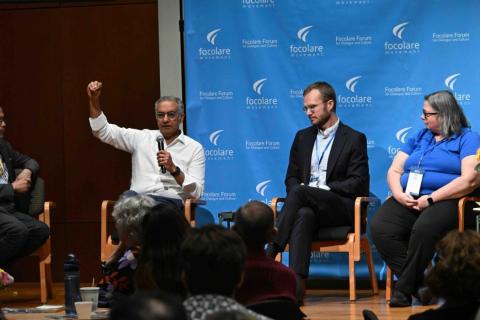A trip with an exceptional guide shows a wealth of fauna, landscapes, languages and traditions that conquer the heart

Photo courtesy of Citta Nuova
We were out on the road when we stopped at the sight of the compact thatched roofs visible just above the tall grass. A small Zulu village lay hidden in the savannah.
We abandoned the car and set out on foot. In front of the first house a refined woman was hanging out clothes to dry. Sylvester, my traveling companion, explained to her that I had come from Rome. She welcomed me smiling and brought us around the village. I admired the mud houses built and finished to perfection; their walls decorated with geometric stripes.
Women and children gathered around us. I didn’t notice any men; maybe they were working in the fields. Someone noticed the small cross I wore around my neck and asked me for a blessing. The villagers were followers of the independent African Church, one of the most powerful in South Africa, a Christianity that coexists with traditional beliefs. Its members have deep respect for Catholics, and I marveled at their warm welcome.
“You will catch more flies with honey than with vinegar,” my spiritual companion, an elderly missionary, reminded me. “First of all, you have to win the hearts of the people. Otherwise, you won’t accomplish very much.”
I had heard that when this missionary once left a village the women called after him, “Carry us with you always in your tarì,” which is the wool scarf or antelope skin mothers secure a child on their backs with. It appears they considered my missionary friend more of a mother figure than a father figure.
Exiting Durban, Sylvester and I soon left the highway to circle the Royal Natal Park. We drove through the great amphitheater of mountains, which drew closer and closer. The journey through the mountain pass brought us up to an altitude of 5,500 feet, and from this height we stopped and looked out over the Kwazulu, the land of the Zulus.
“The Zulus are a tough and proud people,” the missionary’s words reminded me. “But that never discouraged me. I enjoyed being with them. I continued to visit the sick in their huts, to greet everyone, to talk to everyone, to be interested in everything. The language of charity is much more convincing than words alone: it goes straight to the heart.”
We left the province of Kwazulu-Natal and entered the Free State. The landscape changed dramatically. We traveled across a high (6,500 feet) plateau, spotting nearby lakes and distant peaks. It was once an ideal habitat for gazelles, antelopes, zebras and lions. Now we encountered only clusters of baboons, gazing indifferently at the rare passing cars. Overhead the eagles soared.
We came across villages of a few hundred tiny houses built by the government to replace the precarious shacks that were once massed together there. We followed the road towards Sterkfontein Dam Nature Reserve. Once again, the scenery changed: fewer woods and vast stretches of savannah, pastures, clumps of thorny trees.
Another striking amphitheater of mountains stood outlined on the horizon. On our left, peaks of almost 10,000 feet protected the small state of Lesotho. We were in the Golden Gate Highlands National Park with its breathtaking scenery.
Night was upon us as we reached Bloemfontein. From there we left for Kimberley. The savannah became wilder, more beautiful, more solitary, home to animals whose names I did not know, difficult to approach or photograph since they fled at the slightest movement.
Only a small herd of antelopes stopped for a moment before disappearing among the trees. A family of small rodents crossed the road while herds of ostriches grazed in the tall grass.
Kimberley
I had reached the geographical center of South Africa through very different landscape settings. In Durban I had listened to the Zulu language, in Bloemfontein Afrikaans, Sesotho and English, here in Kimberley, Setswana... A wealth of nature and languages that reflects the human and cultural wealth of a great country like South Africa.
In his time, the elderly missionary hadn’t stopped to take in the scenery. He was much more interested in the people he met and in explaining his approach: “The best method, the secret to touching and transforming peoples’ hearts is love. The heart helps you find the right words. What’s important is to love these people, love them despite everything, love them always. They call me to one village or another and I don’t always know the person who has called me. But anyone can call me. It’s so important to make everyone feel welcome, always.”
Yes, my missionary friend from the past... He was indeed my special guide, instructor and soulmate on my journey: Fr. Joseph Gérard, Oblate of Mary Immaculate, who people called the “apostle of Lesotho.” He was 23 when he first arrived in South Africa in 1853. He remained there for 63 years, never once returning to France, his native land. Pope John Paul II proclaimed him beatified on September 15, 1988.
First published in Città Nuova, Italy.











